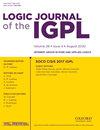Exploiting multimodal biometrics for enhancing password security
IF 0.8
4区 数学
Q2 LOGIC
引用次数: 0
Abstract
Digitization of every daily procedure requires trustworthy verification schemes. People tend to overlook the security of the passwords they use, i.e. they use the same password on different occasions, they neglect to change them periodically or they often forget them. This raises a major security issue, especially for elderly people who are not familiar with modern technology and its risks and challenges. To overcome these drawbacks, biometric factors were utilized, and nowadays, they have been widely adopted due to their convenience of use and ease of hardware installation. Many biometric-based authentication schemes were proposed, but despite the advantages that they offer, recent research has shown that biometrics by itself cannot be considered as an inviolable technique. Recently, we have proposed StegoPass, a novel method that obtains the 68 facial points of a user and utilizes them as a stego message to an image. This produced stego image was the password. Although the experiments conducted showed maximum security, it would be challenging to enhance the robustness of the proposed model for even more attacks. This paper examines the utilization of multimodal biometrics as the secret message embedded in the image. More specifically, besides the extraction of the facial points, we extract the unique minutiae moments and combine them in a feature vector. This feature vector is then embedded in the image. Two different datasets were used, and the security of the method was tested against state-of-the-art deep learning models, i.e. generative adversarial networks, to test whether the image could be digitally synthesized and fool the proposed verification scheme. The results proved that the new enhanced version of StegoPass offers an extremely secure method as its predecessor.利用多模态生物识别技术提高密码安全性
每个日常程序的数字化都需要值得信赖的验证方案。人们往往会忽视他们所使用的密码的安全性,即在不同场合使用相同的密码、忽视定期更改密码或经常忘记密码。这就提出了一个重大的安全问题,尤其是对于不熟悉现代技术及其风险和挑战的老年人来说。为了克服这些弊端,人们开始使用生物识别因素,由于其使用方便、硬件安装简单,如今已被广泛采用。人们提出了许多基于生物识别技术的身份验证方案,但尽管这些方案具有诸多优势,最近的研究表明,生物识别技术本身并不能被视为一种不可侵犯的技术。最近,我们提出了一种新方法 StegoPass,它能获取用户的 68 个面部点,并将其作为图像的隐密信息。生成的偷窃图像就是密码。尽管所进行的实验显示了最大的安全性,但要提高所提出模型的鲁棒性以应对更多的攻击仍具有挑战性。本文研究了如何利用多模态生物识别技术将密文嵌入图像。更具体地说,除了提取面部点之外,我们还提取了独特的特征点时刻,并将它们组合成一个特征向量。然后将该特征向量嵌入图像中。我们使用了两个不同的数据集,并用最先进的深度学习模型(即生成式对抗网络)对该方法的安全性进行了测试,以检验图像是否能被数字合成,以及是否能骗过所提出的验证方案。结果证明,新的增强版 StegoPass 与前者一样,提供了一种极其安全的方法。
本文章由计算机程序翻译,如有差异,请以英文原文为准。
求助全文
约1分钟内获得全文
求助全文
来源期刊
CiteScore
2.60
自引率
10.00%
发文量
76
审稿时长
6-12 weeks
期刊介绍:
Logic Journal of the IGPL publishes papers in all areas of pure and applied logic, including pure logical systems, proof theory, model theory, recursion theory, type theory, nonclassical logics, nonmonotonic logic, numerical and uncertainty reasoning, logic and AI, foundations of logic programming, logic and computation, logic and language, and logic engineering.
Logic Journal of the IGPL is published under licence from Professor Dov Gabbay as owner of the journal.

 求助内容:
求助内容: 应助结果提醒方式:
应助结果提醒方式:


